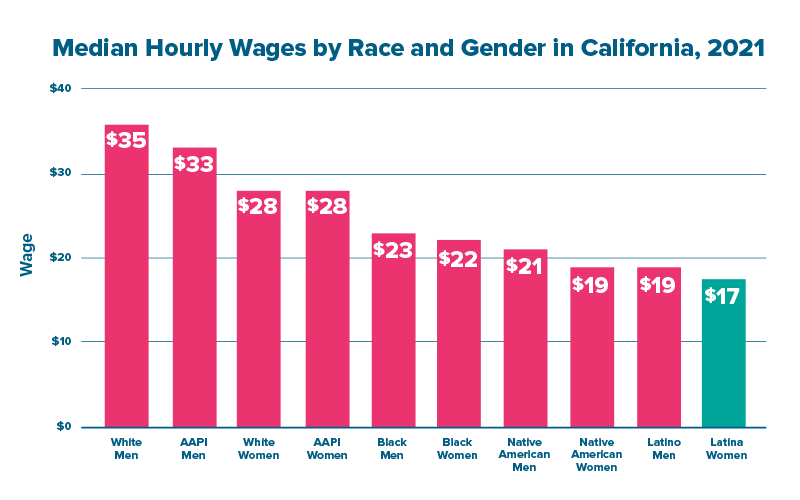Acknowledgments
This data brief was developed in partnership with the UCLA Latina Futures Lab, 2050 and UCLA Chicano Studies Research Center. Core operating support for the UCLA Latino Policy and Politics Institute and the Latina Futures Lab, 2050 is provided by the California Latino Legislative Caucus. We are thankful for the feedback from Celia Lacayo and Rebecca Frazier from the UCLA Chicano Studies Research Center, and Jessica Stender from Equal Rights Advocates.
Introduction
The gender wage gap remains shockingly high in California and is particularly stark for Latinas and other women of color. On Latina “Equal Pay Day” we raise awareness about the persistent wage gap that Latinas continue to face in our country, contributors to the gap, and strategies to close it. At the national level, Latinas on average face a wage gap of 52 cents to every dollar paid to white, non Hispanic men. This number includes all Latinas with reported earnings (full-time year-round, part-time, and seasonal workers). For Latinas working full-time year round, the wage gap is 57 cents. In looking at the wage gap, California is no exception.
Key Findings
1. The Latina workforce in California is large and growing. There are currently more than 3.3 million Latina workers in the state. Among young workers sixteen to forty-four years of age, Latinas outnumber women in other major racial/ethnic groups.

2. Latina workers earn the lowest median wages. In 2021, the median hourly wage for Latinas in California was only $17 per hour—lower than the wage for workers in other major racial/ethnic groups.

3. Latina workers experience a large wage gap, especially if they have a college education. Overall, Latinas earned 49 cents for every dollar earned by non-Hispanic white men in California. Latinas with a bachelor’s degree earned 58 cents for every dollar earned by non-Hispanic white men with a similar level of education. This means the typical Latina worker earned 51 cents less per dollar than a white worker, and a Latina with a bachelor’s degree earned 42 cents less per dollar. (*)
4. Working-age Latina workers experience a large wage gap even after considering factors that determine pay. Educational attainment, years of work experience, occupation and industry, and even our citizenship status can explain some of the gender differences in pay. The remaining gaps not explained by these factors are, in part, attributed to gender and racial discrimination.
5. Latina workers have power. Latinas in California have increasingly joined forces with diverse groups of workers and advocates to demand equal opportunities and wages.

(*) Erratum: The original version of this analysis incorrectly reported Latinas earned 51 cents for every dollar earned by non-Hispanic white men in California and that Latinas with a bachelor’s degree earned 42 cents for every dollar earned by non-Hispanic white men with a similar level of education. The reporting error did not change the qualitative findings of the analysis (Updated 2/29/2024).

